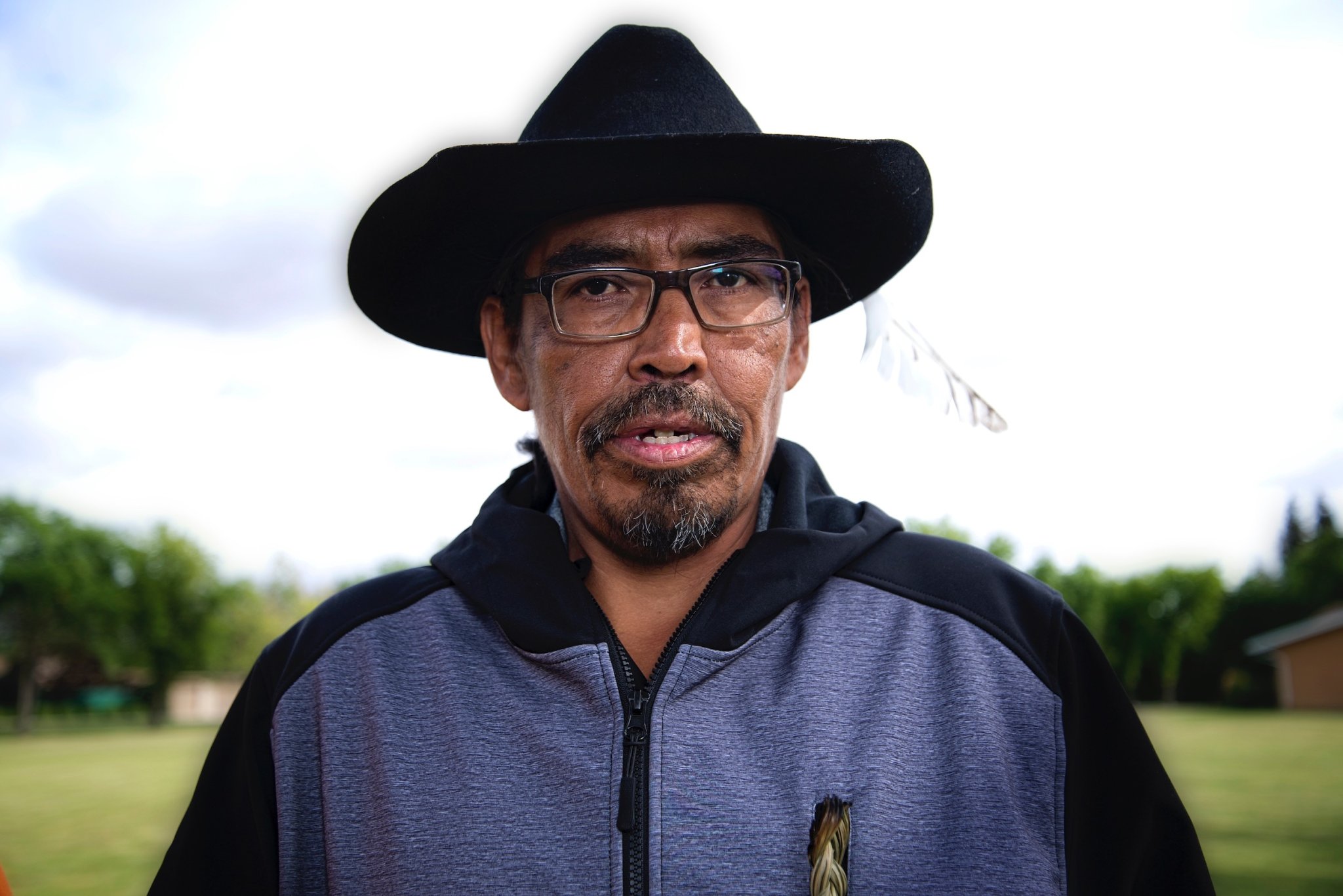

By
Ashleigh Stewart &
Nathaniel Dove
Global News
Published September 12, 2022
12 min read

Brian Burns woke up last Sunday morning to a flurry of missed calls and messages from loved ones telling him something terrible had happened at his home.
Among them were missed calls and texts from his wife, Bonnie.
“Bonnie tried calling me, about 6.30 am, and I was sleeping. She texted me, saying, “Why don’t you answer your goddamn phone?”
Burns, affectionately known as “Buggy” by all who know him, was horseracing about 50 kilometres east of his James Smith Cree Nation (JSCN) home when Myles Sanderson allegedly broke into his home, armed with a knife.
His wife, Bonnie Goodvoice-Burns, 48, and son Gregory “Jonesy” Burns, 28, were murdered in the early morning stabbing spree that left 11 dead and 17 wounded. An ensuing four-day manhunt for Sanderson came to an end on Wednesday when his car was rammed off the road and he was apprehended. He died hours later in custody.
The body of his brother Damien, who is a co-accused in the murders, was found on JSCN-land on Monday.
The families of those Sanderson is accused of murdering are struggling to come to terms with the Sanderson’s deaths, as it means they will never face the consequences of their actions.

Many, like Bonnie, died trying to protect family. Buggy says his wife died trying to save their eldest son and her three other children, and two grandchildren, who were also home at the time.
Five days on from the attacks, Buggy can barely comprehend what happened in the small community of about 1,900 people, where “everyone knows everyone.”
Dressed down in a hoodie and sweatpants, wearing his trademark black fedora with an eagle feather tucked into the side, Buggy cuts a solemn figure as he enters a diner in Melfort, Saskatchewan, about 40 kilometres from JSCN. He is ready to share his grief.
In his first interview, he tells Global News he wants Bonnie to be remembered for the support she gave him and their community, and for her heroic final actions.
“I’m shattered. I’m broken. My heart’s in a million pieces right now. I always thought I’d be the first one to go. And then you bury your son and wife at the same time.”
As he speaks, Buggy stares intently at the plate of food in front of him, his eyes downcast. He occasionally glances up from under the brim of his fedora, but rarely makes eye contact. He is still in shock, he admits, and doesn’t know if that will ever go away.
But he also wants to speak about the drug and alcohol issues in his community, which are believed to have played a role in the murders. Myles Sanderson had a history of substance abuse, according to his hefty court file.
Buggy says he would never have survived a life of crime, drug and alcohol addiction and abuse if it wasn’t for his wife. His son had fallen into a similar trap.
“She was my rock,” he says. “I had some pretty bleak years. But Bonnie stuck in there with me.”
Buggy is a well-known figure in not only the JSCN community, but also in the surrounding area. As he recounts his story at the diner with his nephew Shawn Burns by his side, he is twice approached by friends and loved ones offering their condolences. Later, the wait staff, having recognized him, would wipe his food order from the bill.
Buggy settles into his seat and orders steak and eggs. It’s going to be a big day, he says, with a potential two-hour drive to Saskatoon to pick up his son’s body.
When asked how he’s feeling, he says “shattered.” On top of caring for his three boys — Dayson, 13, Mason, 11 and Grayson, 9, two grandchildren — a three-month-old, Bonnie’s niece, and one aged 18 months, Gregory’s child, he is also organizing two funerals.
“Yesterday was tough, picking out caskets for my wife and son,” he says, staring downwards at his breakfast.
On Saturday, September 3, the night before the murders, Buggy was away at a horseracing tournament. Between 9:30pm and 10pm, his wife called. She was scared and upset.
He went to sleep, hoping they would be safe. Meanwhile, at home, chaos was unfolding.
Shawn awoke around 6:40 am to a private message on Facebook from Buggy’s son Dayson.
“He said his Mum was gone and to get down there. I went flying down to his house as fast as I could,” Shawn tells Global News.
“It’s about a five to six-minute drive from my house, on the south of the reserve. When I got there, I saw the bodies just lying there and some of the people told me what happened.”
Gregory and Bonnie’s bodies lay in the driveway alongside Gloria Burns, a 62-year-old addictions counsellor and Bonnie’s close friend. Gloria had been responding to an early morning crisis call from Bonnie when she was caught in the attacks.
A window in their basement was broken, Buggy says, which is how the Sandersons — Myles and Damien — allegedly gained access. He does not know why Gregory was targeted.
“The house was so bloody, it was all over the kitchen. They chased Gregory through the house and caught up to him outside. Bonnie went outside to try to help,” Shawn says.
Meanwhile, Dayson, Buggy’s second-eldest, had locked his two brothers and the two babies in a bedroom and told them not to come out. He was stabbed in the neck during the frenzy.
“I went inside immediately to check on the boys,” Shawn says.
When Buggy woke up to the news at about 7:30 am, he was in shock. He told his teammates he needed to go home. Despite a lucrative race scheduled for that morning, his entire team insisted on packing up and going with him.
Upon his return, Shawn and an RCMP officer picked Burns up to take him home.
“There was blood everywhere. I want to go check on my boy, to go hold him. But … they said let forensics do their job. So we sat there waiting and waiting. Watching them .. crying and waiting.”
At about 5 pm, investigators allowed families to say their goodbyes. The bodies had been moved from the crime scene to the lawn, Buggy says.
“But we still couldn’t see them because they were in body bags.”
Dayson had been taken to hospital with the wounded but was discharged the same day. He’d needed three stitches for his stab wound. The entire family is now living in a hotel in Melfort.
Buggy doesn’t know if there might have been a different outcome if he wasn’t away that weekend.
“What if I was home? Maybe this would have never happened,” he says.
“Or maybe I would have been the fourth victim there on the ground.”
Bonnie was a popular figure in the community. Previously a janitor at the school, she was more recently part of their COVID-19 response team and was charged with taking people’s temperature at the entrance and disinfecting the playground.
Bonnie and Buggy’s house had an open door policy, being a popular place for neighbourhood children to sleep over or for Bonnie to feed anyone who was hungry.
Buggy and Shawn start giggling as they recall her gentle, but “cheeky” nature.
“She was lovely, caring and generous,” Buggy says, grinning into his plate of steak and eggs. “She was lovable and cheeky, she was always ribbing somebody.”
Shawn laughs. “Yes, definitely cheeky.”
Buggy smiles to himself as he recalls meeting Bonnie 32 years ago during a pow wow in Prince Albert. He was just 18 when the couple welcomed their first son, Gregory.
“I married her on her birthday so I would never forget it. It would be our 17th anniversary this month,” Buggy says.
But it was a tumultuous marriage. Buggy struggled with addictions and was jailed “a few times” for assaults.
“I was sexually abused by a family member on reserve at a very young age. And I started hating everybody, you know, getting into fights in school. And they didn’t know how to challenge that trauma, I guess you could say,” Buggy says.
Buggy doesn’t shy away from his past. He speaks openly about abusing alcohol, a long cocaine addiction and dabbling in methylamphetamine, commonly known as crystal meth, for six months. He spent decades in and out of jail for assaults.
“I was a violent, violent guy when I first started out as an 18-year-old. I had a rap sheet, I spent time in Prince Albert Correctional, Saskatoon Correctional, Regina Correctional,” he says.
Bonnie was the only thing that got him through and sober, he says. He’s now been clean for about six years.
“She never left my side. She was there to comfort me and hold me, whatnot, to talk to me. She was a loving and caring person, kind-hearted,” he says.
She was also the person who helped him into treatment.
“Once I went to treatment and when I got counseling and talking to elders, that helped me release that ugliness.”
Buggy hopes by sharing his own story, others might be prompted to seek help. Last year, the couple took in a young James Smith member who was trying to kick his crystal meth addiction. JSCN has long had a drug and alcohol abuse problem among its members, he says.
His old demons also came for his son. Greg had been to jail “a few times” for assaults too, Buggy says. He’d also started using crystal meth.
“He tried to hide it,” Buggy says. “But I knew.”
Buggy worked in construction and would often take Gregory along with him. His son had wanted to work in mining, he says, but had been “distracted by girls.” Gregory had two children and Buggy believes there was another one on the way. Bonnie and Buggy were caring for his 18-month-old from a previous relationship.
In order to break the cycle, he says, JSCN needs more tools, counsellors and mental health funding. But those at-risk also need to help themselves.
“Just go seek help, like professional help. Like there’s therapists, counselling, whatever. Go out there and get it, make the effort. You’ve got to put in the effort to get the counseling and whatnot and take all these programs. You’ll be alright. It helps. It helped me,” Buggy says.
He didn’t know Myles well but said some people in the community were afraid of him. “Not me though,” he smirks.
The day Sanderson was apprehended, the family had been in Saskatoon to hold a press conference in honour of Bonnie and Gregory. Buggy didn’t speak during the press conference. He was too emotional.
On their way back to Melfort, they saw RCMP cars fly past and thought it might be connected with the emergency alert that had just gone out about a stolen car, which Sanderson was believed to be driving.
They followed the cars and arrived on the scene shortly after Sanderson’s car had been shunted off the road and he’d been apprehended.
“I went over and shook all of the RCMP officer’s hands and hugged them. I was so happy,” he says.
That night, Dayson slept through the night for the first time.
Buggy is trying to be strong for his boys. He wakes up crying every morning and lets himself weep for as long as the tears come, because that’s when his sons are sleeping. At other times, he tries to keep a brave face.
Midway through his next statement, a man approaches him from behind and puts his arm on his shoulder. Buggy leaps up and the two men embrace, both crying.
“Bonnie’s cousin,” Buggy says as he returns to his seat and dries his eyes. He’d asked him to be a pallbearer at the funeral.
His support system — friends and family — is his only source of strength right now, he says.
“If it wasn’t for them, I’d probably have gone to the deep side back to where I was before, lost in my addictions, cocaine, crystal meth, alcohol.”
At his hotel in Melfort, in the wake of the murders, Buggy recalls running into Sanderson’s mother. He doesn’t hold any ill-will towards her.
“She came up to me and was crying, saying ‘I’m so sorry.’ I gave her a hug and said it’s not your fault. I’m not mad at you,” he says.
That forgiveness is important for the community. But so is closure. Funerals for the dead will take place over the weekend and next week.
Bonnie’s body is ready to be taken home, but Buggy is waiting to hear about the release of his son’s body so he can take them back to JSCN together, with a stop in Prince Albert on the way, where Bonnie is from.
As Buggy stands to leave, another friend comes over to embrace him. He seems to be a popular man, we say. He shrugs. That’s just how it is around here, he replies. The community is very close.
But his wife and son’s final journey to James Smith Cree Nation might also be his last. He does not know what the future holds for his family.
“I don’t know if I’ll ever go home. It’s up to my boys. Maybe we will build a new house and start fresh. I don’t know,” he says.
“We will see.”



Comments